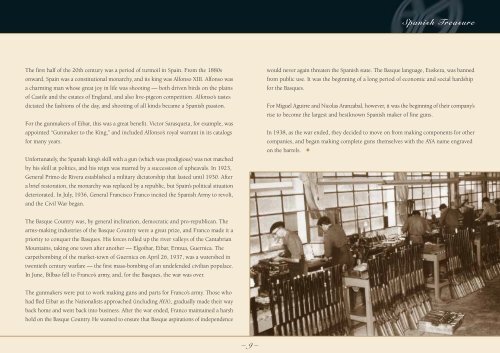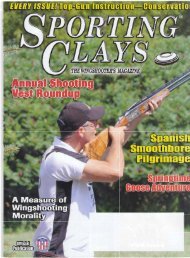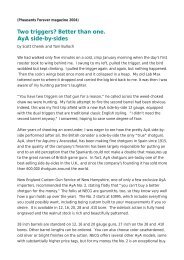. Cat.logo_AYA(1-15).fh8 - AYA, Aguirre y Aranzabal
. Cat.logo_AYA(1-15).fh8 - AYA, Aguirre y Aranzabal
. Cat.logo_AYA(1-15).fh8 - AYA, Aguirre y Aranzabal
Create successful ePaper yourself
Turn your PDF publications into a flip-book with our unique Google optimized e-Paper software.
The first half of the 20th century was a period of turmoil in Spain. From the 1880s<br />
onward, Spain was a constitutional monarchy, and its king was Alfonso XIII. Alfonso was<br />
a charming man whose great joy in life was shooting — both driven birds on the plains<br />
of Castile and the estates of England, and also live-pigeon competition. Alfonso’s tastes<br />
dictated the fashions of the day, and shooting of all kinds became a Spanish passion.<br />
For the gunmakers of Eibar, this was a great benefit. Victor Sarasqueta, for example, was<br />
appointed “Gunmaker to the King,” and included Alfonso’s royal warrant in its catalogs<br />
for many years.<br />
Unfortunately, the Spanish king’s skill with a gun (which was prodigious) was not matched<br />
by his skill at politics, and his reign was marred by a succession of upheavals. In 1923,<br />
General Primo de Rivera established a military dictatorship that lasted until 1930. After<br />
a brief restoration, the monarchy was replaced by a republic, but Spain’s political situation<br />
deteriorated. In July, 1936, General Francisco Franco incited the Spanish Army to revolt,<br />
and the Civil War began.<br />
The Basque Country was, by general inclination, democratic and pro-republican. The<br />
arms-making industries of the Basque Country were a great prize, and Franco made it a<br />
priority to conquer the Basques. His forces rolled up the river valleys of the Cantabrian<br />
Mountains, taking one town after another — Elgoibar, Eibar, Ermua, Guernica. The<br />
carpetbombing of the market-town of Guernica on April 26, 1937, was a watershed in<br />
twentieth century warfare — the first mass-bombing of an undefended civilian populace.<br />
In June, Bilbao fell to Franco’s army, and, for the Basques, the war was over.<br />
The gunmakers were put to work making guns and parts for Franco’s army. Those who<br />
had fled Eibar as the Nationalists approached (including <strong>AYA</strong>), gradually made their way<br />
back home and went back into business. After the war ended, Franco maintained a harsh<br />
hold on the Basque Country. He wanted to ensure that Basque aspirations of independence<br />
– 9 –<br />
Spanish Treasure<br />
would never again threaten the Spanish state. The Basque language, Euskera, was banned<br />
from public use. It was the beginning of a long period of economic and social hardship<br />
for the Basques.<br />
For Miguel <strong>Aguirre</strong> and Nicolas <strong>Aranzabal</strong>, however, it was the beginning of their company’s<br />
rise to become the largest and bestknown Spanish maker of fine guns.<br />
In 1938, as the war ended, they decided to move on from making components for other<br />
companies, and began making complete guns themselves with the <strong>AYA</strong> name engraved<br />
on the barrels. ✦




